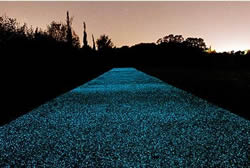Glow-in-the-Dark Paths Coming to Local Parks
Glow-in-the-dark paths are coming to parks in Hammersmith and Fulham as our borough becomes the first to use Starpath, a spray-on coating that can be used on any solid surface which works by absorbing UV rays during the day and then expelling them at night - creating a blue glow that lights up the surface.
Starpath's makers - Pro-Teq Surfacing UK - are initially applying the product to the main commuter route through the William Parnell Park in Fulham.
And if it proves popular, it could spread to other dark corners of the borough.
The council says not only will Starpath brighten up the dimly-lit park's path at night without needing to resort to traditional, costly and more intrusive lighting, its application process helps repair and reinforce surfaces on to which it is sprayed.
Councillor Nicholas Botterill, H&F Council's leader, says: "It may look like something out of science fiction film but this product has very real benefits.
"As well as improving safety by lighting up one of our less well lit parks, Starpath is environmentally sound, with no ongoing energy costs or light pollution - and it breathes new life into old pathways.
"If Starpath proves popular with park users here it could be rolled out to other under-lit public places in the borough that are a little more off the beaten track."
Starpath contains a bioluminescent material that glows brighter the darker it gets. It will be used alongside the existing lighting in and around William Parnell Park, or the Pineapple Park as it is known locally.
The council says installing the Starpath will cost about £24,700, but it is expected to reduce annual pathway repair costs significantly as it comes with a seven year warranty, and has the potential to cut the council's carbon footprint.
The finished surface is non-slip and water-resistant, making it ideal for pedestrians or cyclists.
It has recently been trialled in Christ's Pieces park, in Cambridge, where 150 square metres of path were converted and ready for use in less than four hours.
February 21, 2014
